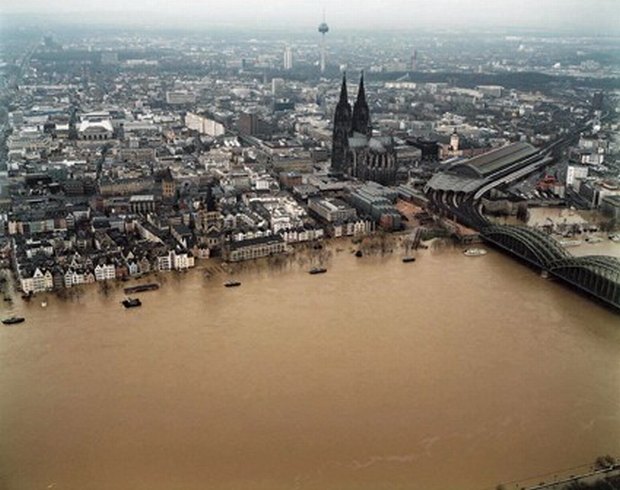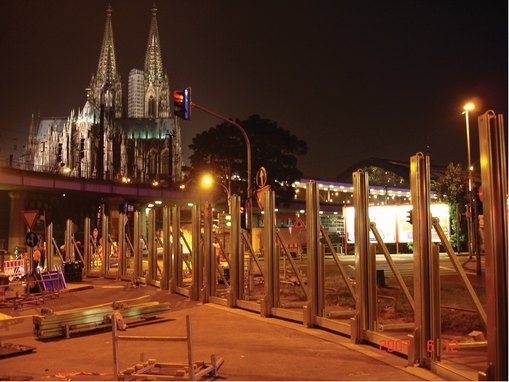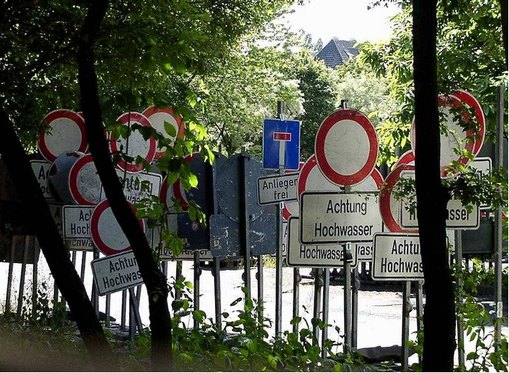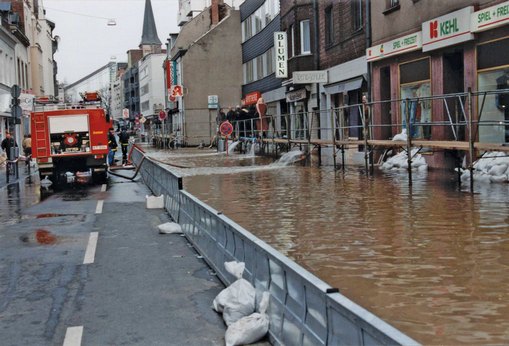
Spring Flood of the Rhine at Cologne in 1995. Photo: Flood Protection Center Cologne - M.Jochum, Avia Luftbild
In Cologne the climate change adaptation measures currently in place comprise only those measures used directly to counter the flood hazard. These measures began life as a 'quick start programme' set up immediately after the floods in 1993 and 1995 which resulted in a Flood Protection Concept (1996).
This concept was a novel one at that time. Its philosophy is based on the simple truth that disastrous floods are natural and will happen from time to time. In consequence this means that there is a risk – potentially also behind barriers and dykes. The reaction strategy is then based on three pillars which are:
Preventive flood protection
- Measures to reduce discharge (to create retention areas, to avoid soil sealing, to re-nature streams)
- Measures to minimize damage (to prohibit new building in flood-prone areas, to construct and to use buildings in a flood resistant manner, to communicate with the public and stakeholders about their behaviour in the event of a flood)
Structural flood protection
- Above all, dykes, flood protection barriers and doors
- To avoid flooding via the drainage system
- To ensure the operations of the sewage networks
- To protect public utilities/functions such as electricity, gas and water
Flood management
- to set up a flood protection control centre
- rules on how this centre works par-ticularly in respect of competences for evacuation
Responsibilities
Of course, when it comes to a cross-sectoral and multifaceted topic like climate change adaptation, numerous interlinkages and questions regarding responsibilities and the division of tasks inevitably emerge.
It should however be noted that, in the field of climate change, adaptation, the issue of apportioning responsibility is currently in flux. Though one does not need to be a prophet to predict that on the Federal level little more than framework conditions and possibly funding programmes will emerge. In consequence it is obvious that adaptation measures, in the main, must be developed and implemented at the regional and local levels.
On local level then it is likely that it is the City administration that will be tasked with doing something. In cases like Cologne however it is not easy to form a strong local alliance of responsible departments where the local political situation does not specifically demand it.
Given recent history however Cologne does exhibit a high level of political awareness in respect of the flooding issue such that it is likely that other adaptation measures will be linked to it.
Future challenges
From an external perspective it is recommended that Cologne should revise its flood protection strategy in order to fully integrate future water balance trends with other fields of climate change adaptation. Furthermore this more holistic approach should be linked to the climate change protection measures which are currently being undertaken in order to better link these two basic fields of action.
By Dr. Jürgen Neumüller, Infrastruktur & Umwelt, Potsdam, Germany, [email protected]
On the Rhine
Cologne was founded about 2000 years ago by the Romans. Strategically situated along the banks of the Rhine River for more then four centuries it was their capital in the region. Nowadays, Cologne is a vibrant metropolis in the German state of North-Rhine-Westphalia and with about one million inhabitants it is Germany's fourth largest city after Berlin, Hamburg and Munich. The cultural and economic centre of the region is internationally famous for the Cologne Carnival and Cologne Cathedral which is a UNESCO world heritage site.
Cologne and the Rhine River are connected to each other in manifold ways. The Rhine, with a total length of 1324km, rises in Switzerland and flows through Austria, Germany and the Netherlands while bordering France and Liechtenstein. In its lower and middle sections it is one of the most frequented waterways in the world.
Many cities along its course, including Cologne, have successfully utilised the riverside for urban development purposes. From time to time, however, severe floods along the course of the river have occurred as with the two successive so-called '100 year floods' in 1993 (water level at 'Cologne gauge: 10.63 m) and 1995 (10.69 m).
The last comparable flood hit Cologne more than 67 years previously. Both recent floods came in the spring resulting from a combination of snow melt in the alpine area and heavy rainfall in the upper basin.
The damage caused by the 1993 flood amounted to some €75million where as in 1995 it was much less at around €32 million. This demonstrated that better risk awareness management pays dividends.

Preparing for spring floods in Cologne. Photo: Gerald Fuchs

Achtung Hochwasser - Attention High waters. Photo: Reinhard Vogt

Mobil protection system against floods. Photo: Reinhard Vogt
By Dr. Jürgen Neumüller